Integrating Land-Cover Products Based on Ontologies and Local Accuracy
Abstract
1. Introduction
2. Method
2.1. Integration on the Schema Level
2.1.1. Ontology-Based Data Integration Approach Selection
2.1.2. Construction of a Global Vocabulary
2.1.3. Local Ontologies
2.1.4. Ontology Mapping-Similarity Calculation
Ontology Mapping Based on Term
Similarity Calculation Method Based on Attributes
Instance-Based Ontology Mapping
Synthesis of Mapping Methods
2.2. Integration on the Data Level
2.2.1. Using Geostatistics to Obtain the Local Accuracy Map of Source Data
2.2.2. Land-Cover Data Integration
Integration Model I
Integration Model II
3. Results
3.1. Data
3.1.1. Source Land-Cover Data
3.1.2. Reference Data
3.2. Result of Schema-Level Integration
3.2.1. Ontology Mapping Based on Term
3.2.2. Ontology Mapping Based on Attributes
3.2.3. Ontology Mapping Based on Instance
3.2.4. Synthesis of Mapping Results
3.3. Result of Data Level Integration
3.3.1. Local Accuracy
3.3.2. Integration Results
3.4. Accuracy Analysis
4. Discussions
5. Conclusions
Author Contributions
Funding
Institutional Review Board Statement
Informed Consent Statement
Data Availability Statement
Conflicts of Interest
References
- Zhu, Y.Q.; Pan, P. Concept Method and Application of Geospatial Data Ontology; Science Press: Beijing, China, 2019. [Google Scholar]
- Zhu, L.; Jia, T.; Shi, R.M. Global Surface Covering Product Update and Integration; Science Press: Beijing, China, 2020. [Google Scholar]
- Loveland, T.R.; Reed, B.C.; Brown, J.F.; Ohlen, D.O.; Zhu, Z.; Yang, L. Development of a global land cover characteristics database and igbp discover from 1 km avhrr data. Int. J. Remote Sens. 2000, 21, 1303–1330. [Google Scholar] [CrossRef]
- Hansen, M.C.; Defries, R.S.; Townshend, J.; Sohlberg, R.A. Global land cover classification at 1 km spatial resolution using a classification tree approach. Int. J. Remote Sens. 2000, 21, 1331–1364. [Google Scholar] [CrossRef]
- Friedl, M.A.; Sulla-Menashe, D.; Tan, B.; Schneider, A.; Ramankutty, N.; Sibley, A.; Huang, X. Modis collection 5 global land cover: Algorithm refinements and characterization of new datasets. Remote Sens. Environ. 2010, 114, 168–182. [Google Scholar] [CrossRef]
- Bartholome, E.; Belward, A.S. Glc2000: A new approach to global land cover mapping from earth observation data. Int. J. Remote Sens. 2005, 26, 1959–1977. [Google Scholar] [CrossRef]
- Bicheron, P.; Defourny, P.; Brockmann, C.; Schouten, L.; Vancutsem, C.; Huc, M.; Bontemps, S.; Leroy, M.; Frédéric, A.; Herold, M.; et al. Globcover—Products description and validation report. Foro Mund. Salud 2011, 17, 285–287. [Google Scholar]
- CCI-LC. Product User Guide; CCI-LC: Louvain-la-Neuve, Belgium, 2014. [Google Scholar]
- Ryutaro, T.; Thanh, H.N.; Toshiyuki, K.; Bayan, A.; Gegen, T.; Xuan, P.D. Production of global land cover data-glcnmo2008. J. Geogr. Geol. 2014, 6. [Google Scholar] [CrossRef]
- Chen, J.; Liao, A.; Chen, J.; Peng, S.; Chen, L.; Zhang, H. 30m Global Land Cover Remote Sensing Data Product-Globe Land30. Geogr. Inf. World 2017, 24, 1–8. (In Chinese) [Google Scholar] [CrossRef]
- Yu, L.; Wang, J.; Gong, P. Improving 30m global land-cover map FROM-GLC with time series MODIS and auxiliary data sets: A segmentation-based approach. Int. J. Remote Sens. 2013, 34, 5851–5867. [Google Scholar] [CrossRef]
- Gong, P.; Liu, H.; Zhang, M.; Song, L. Stable classification with limited sample: Transferring a 30-m resolution sample set collected in 2015 to mapping 10-m resolution global land cover in 2017. Sci. Bull. 2019, 64, 370–373. [Google Scholar] [CrossRef]
- Gorelick, N.; Hancher, M.; Dixon, M.; Ilyushchenko, S.; Moore, R. Google earth engine: Planetary-scale geospatial analysis for everyone. Remote Sens. Environ. 2017, 202. [Google Scholar] [CrossRef]
- Xu, P.; Herold, M.; Tsendbazar, N.E.; Clevers, J. Towards a comprehensive and consistent global aquatic land cover characterization framework addressing multiple user needs. Remote Sens. Environ. 2020, 250, 112034. [Google Scholar] [CrossRef]
- Zhang, X.; Liu, L.; Wu, C.; Chen, X.; Zhang, B. Development of a global 30-m impervious surface map using multi-source and multi-temporal remote sensing datasets with the Google Earth Engine platform. Earth Syst. Sci. Data 2020, 12, 1625–1648. [Google Scholar] [CrossRef]
- Herold, M.; Linda, S.; Nandin-Erdene, T.; Steffen, F. Towards an integrated global land cover monitoring and mapping system. Remote Sens. 2016, 8. [Google Scholar] [CrossRef]
- Pérez Hoyos, A.; García Haro, F.J.; San Miguel Ayanz, J. A methodology to generate a synergetic land-cover map by fusion of different: Land-cover products. Int. J. Appl. Earth Obs. Geoinf. 2012, 19, 72–87. [Google Scholar] [CrossRef]
- Jung, M.; Henkel, K.; Herold, M.; Churkina, G. Exploiting synergies of global land cover products for carbon cycle modeling. Remote Sens. Environ. 2006, 101, 534–553. [Google Scholar] [CrossRef]
- Kinoshita, T.; Iwao, K.; Yamagata, Y. Creation of a global land cover and a probability map through a new map integration method. Int. J. Appl. Earth Obs. Geoinf. 2014, 28, 70–77. [Google Scholar] [CrossRef]
- Dmitry, S.; Linda, S.; Myroslava, L.; Mccallum, I.; Fritz, S.; Salk, C.; Moltchanova, E.; Perger, C.; Shchepashchenko, M.; Shvidenko, A. Development of a global hybrid forest mask through the synergy of remote sensing, crowdsourcing and FAO statistics. Remote Sens. Environ. 2015, 162, 208–220. [Google Scholar] [CrossRef]
- See, L.; Dmitry, S.; Myroslava, L.; Ian, M.; Steffen, F.; Alexis, C.; Christoph, P.; Christian, S.; Zhao, Y.Y.; Victor, M. Building a hybrid land cover map with crowdsourcing and geographically weighted regression. ISPRS J. Photogramm. Remote Sens. 2015, 103, 48–56. [Google Scholar] [CrossRef]
- Tsendbazar, N.-E.; de Bruin, S.; Steffen, F.; Herold, M. Spatial accuracy assessment and integration of global land cover datasets. Remote Sens. 2015, 7, 15804–15821. [Google Scholar] [CrossRef]
- Tsendbazar, N.-E.; de Bruin, S.; Mora, B.; Schouten, L.; Herold, M. Comparative assessment of thematic accuracy of GLC maps for specific applications using existing reference data. Int. J. Appl. Earth Obs. Geoinf. 2016, 44, 124–135. [Google Scholar] [CrossRef]
- Xu, G.; Zhang, H.; Chen, B.; Zhang, H.; Yan, J.; Chen, J.; Che, M.; Lin, X.; Dou, X. A bayesian based method to generate a synergetic land-cover map from existing land-cover products. Remote Sens. 2014, 6, 5589–5613. [Google Scholar] [CrossRef]
- Zhu, L.; Jin, G.; Zhang, X.; Shi, R.; La, Y.; Li, C. Integrating global land cover products to refine GlobeLand30 forest types: A case study of conterminous United States (CONUS). Int. J. Remote Sens. 2021, 42, 2105–2130. [Google Scholar] [CrossRef]
- Anderson, J.R.; Hardy, E.E.; Roach, J.T.; Witmer, R.E. A Land Use and Land Cover Classification System for Use with Remote Sensor Data; US Government Print Office: Washington, DC, USA, 1976. [Google Scholar]
- Kerski, J.J. Encyclopedia of geographic information science. J. Geogr. 2011, 110, 177. [Google Scholar] [CrossRef]
- Cui, W. Using Ontology to Realize Semantic Integration and Interoperability of Geographic Information System. Ph.D. Thesis, Wuhan University, Wuhan, China, 2004. [Google Scholar]
- Herold, M.; Woodcock, C.E.; Gregorio, A.D.; Mayaux, P.; Belward, A.S.; Latham, J.; Schmullius, C.C. A joint initiative for harmonization and validation of land cover datasets. Trans. Geosci. Remote Sens. 2006, 44, 1719–1727. [Google Scholar] [CrossRef]
- Jansen, L.; Gregorio, A.D. Land Cover Classification System (LCCS): Classification Concepts and User Manual; Food and Agriculture Organization of the United Nations: Rome, Italy, 1998. [Google Scholar]
- Arnold, S.; Kosztra, B.; Banko, G.; Smith, G.; Hazeu, G.W.; Bock, M.; Sanz, N. Valcarcel. The EAGLE concept—A vision of a future European Land Monitoring Framework. In Proceedings of the Earsel Symposium Towards Horizon, Europe, CNR, Matera, Italy, 3–6 June 2013; pp. 551–568. [Google Scholar]
- Ran, Y.H.; Li, X.; Lu, L. Large-scale land cover mapping with the integration of multi-source information based on the Dempster–Shafer theory. Int. J. Geogr. Inf. Sci. 2012, 26, 169–191. [Google Scholar] [CrossRef]
- Fritz, S.; You, L.; Bun, A.; See, L.; Mccallum, I.; Schill, C.; Perger, C.; Liu, J.; Hansen, M.; Obersteiner, M. Cropland for sub-Saharan Africa: A synergistic approach using five land cover data sets. Geophys. Res. Lett. 2011, 38, 155–170. [Google Scholar] [CrossRef]
- Giri, C.; Zhu, Z.; Reed, B. A comparative analysis of the Global Land Cover 2000 and MODIS land cover data sets. Remote Sens. Environ. 2005, 94, 23–132. [Google Scholar] [CrossRef]
- McCallum, I.; Obersteinr, M.; Nilsonn, S.; Shvidenko, A. A spatial comparison of four satellite derived 1 km global land cover datasets. Int. J. Appl. Earth Obs. Geoinf. 2006, 8, 246–255. [Google Scholar] [CrossRef]
- Herold, M.; Mayaux, P.; Woodcock, C.E.; Baccini, A.; Schmullius, C. Some challenges in global land cover mapping: An assessment of agreement and accuracy in existing 1 km datasets. Remote Sens. Environ. 2008, 112, 2538–2556. [Google Scholar] [CrossRef]
- Wang, H.; Qi, G.; Chen, H. Knowledge Graph: Method, Practice and Application, 1st ed.; Electronic Industry Press: Beijing, China, 2020. [Google Scholar]
- Studer, R.; Richard, B.; Fensel, D. Knowledge engineering: Principles and methods. Data Knowl. Eng. 1998, 25, 161–197. [Google Scholar] [CrossRef]
- Agarwal, P. Ontological considerations in GIScience. Int. J. Geogr. Inf. Sci. 2005, 19, 501–536. [Google Scholar] [CrossRef]
- Visser, P.; Jones, D.M.; Bench-Capon, T.; Shave, M. An Analysis of Ontological Mismatches: Heterogeneity versus Interoperability. In Proceedings of the AAAI 1997 Spring Symposium on Ontological Engineering, Stanford University, Stanford, CA, USA, 24–26 March 1997. [Google Scholar]
- Reynaud, C.; Safar, B. Exploiting WordNet as Background Knowledge. In Proceedings of the 2nd International Workshop on Ontology Matching (OM-2007) Collocated with the 6th International Semantic Web Conference (ISWC-2007) and the 2nd Asian Semantic Web Conference (ASWC-2007), Busan, Korea, 11 November 2007. [Google Scholar]
- Ekaputra, F.J.; Sabou, M.; Serral, E.; Kiesling, E.; Biffl, S. Ontology-based data integration in multi-disciplinary engineering environments: A review. Open J. Inf. Syst. 2017, 4, 1–26. [Google Scholar]
- Ahlqvist, O. Semantic issues in land-cover analysis: Representation, analysis, and visualization (Chapter 3). In Remote Sensing of Land Use and Land Cover, Principles and Applications; CRC Press: Boca Raton, FL, USA, 2012. [Google Scholar] [CrossRef]
- Arvor, D.; Belgiu, M.; Falomir, Z.; Mougenot, I.; Durieux, L. Ontologies to interpret remote sensing images: Why do we need them? Giscience Remote Sens. 2019, 56, 911–939. [Google Scholar] [CrossRef]
- Hall, M. A Semantic Similarity Measure for Formal Ontologies. Master’s Thesis, Fakultat fur Wirtschaftswissenschaften and Informatik, Alpen-Adria Universitat Klagenfurt, Klagenfurt, Austria, 2006. [Google Scholar]
- Homer, C.; Dewitz, J.; Yang, L.; Jin, S.; Danielson, P.; Xian, G.; Coulston, J.; Herold, N.; Wickham, J.; Megown, K. Completion of the 2011 national land cover database for the conterminous united states—Representing a decade of land cover change information. Photogramm. Eng. Remote Sens. 2015, 5, 345–354. [Google Scholar] [CrossRef]
- Gong, P.; Wang, J.; Yu, L.; Chen, J. Finer resolution observation and monitoring of global land cover: First mapping results with Landsat TM and ETM+ data. Int. J. Remote Sens. 2013, 34, 48. [Google Scholar] [CrossRef]
- Wu, Z.; Palmer, M. Verbs semantics and lexical selection. In Proceedings of the 32nd Annual Meeting on Association for Computational Linguistics (COLING-94), Association for Computational Linguistics, New Mexico State University, Las Cruces, NM, USA, 27–30 June 1994. [Google Scholar]
- He, J.; Gao, Z.; Lu, Q.; Zhai, Y. Element level ontology matching based on Lexical Similarity. Comput. Eng. 2006, 32, 185–187. [Google Scholar] [CrossRef]
- Doan, A.H.; Madhavan, J.; Dhamankar, R.; Domingos, P.; Halevy, A. Learning to match ontologies on the semantic web. VLDB J. 2003, 12, 303–319. [Google Scholar] [CrossRef]
- Song, Y. Research on the Method of Constructing Knowledge Map Based on Ontology. Master’s Thesis, Hunan University, Changsha, China, 2013. [Google Scholar]
- Yang, L.; Jin, S.; Danielson, P.; Homer, C.; Gass, L.; Bender, S.M.; Case, A.; Costello, C.; Dewitz, J.; Fry, J. A new generation of the united states national land cover database: Requirements, research priorities, design, and implementation strategies. ISPRS J. Photogramm. Remote Sens. 2018, 146, 108–123. [Google Scholar] [CrossRef]
- Wickham, J.; Stephen, V.; Stehman, L.; Gass, L.; Dewitz, J.; Sorenson, D.; Granneman, B.; Poss, R.; Baer, L. Thematic accuracy assessment of the 2011 national land cover database (NLCD). Remote Sens. Environ. 2017, 191, 328–341. [Google Scholar] [CrossRef]
- Goergen M, T. The State of America’s Forests. J. For. 2007, 105, 229. [Google Scholar]
- Li, W.D. Forest resources and their utilization in the United States. World For. Res. 2006, 19, 61–64. [Google Scholar]
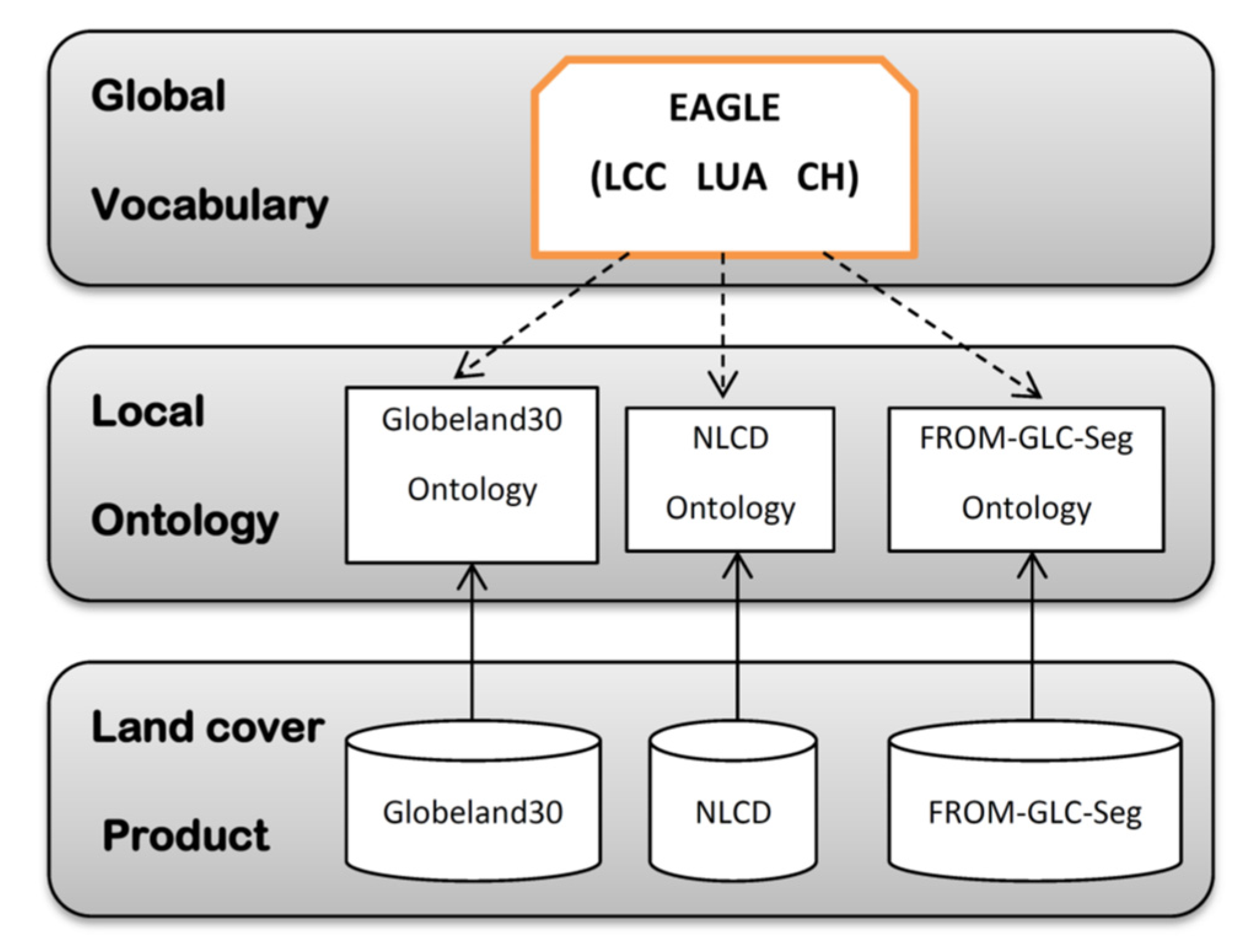
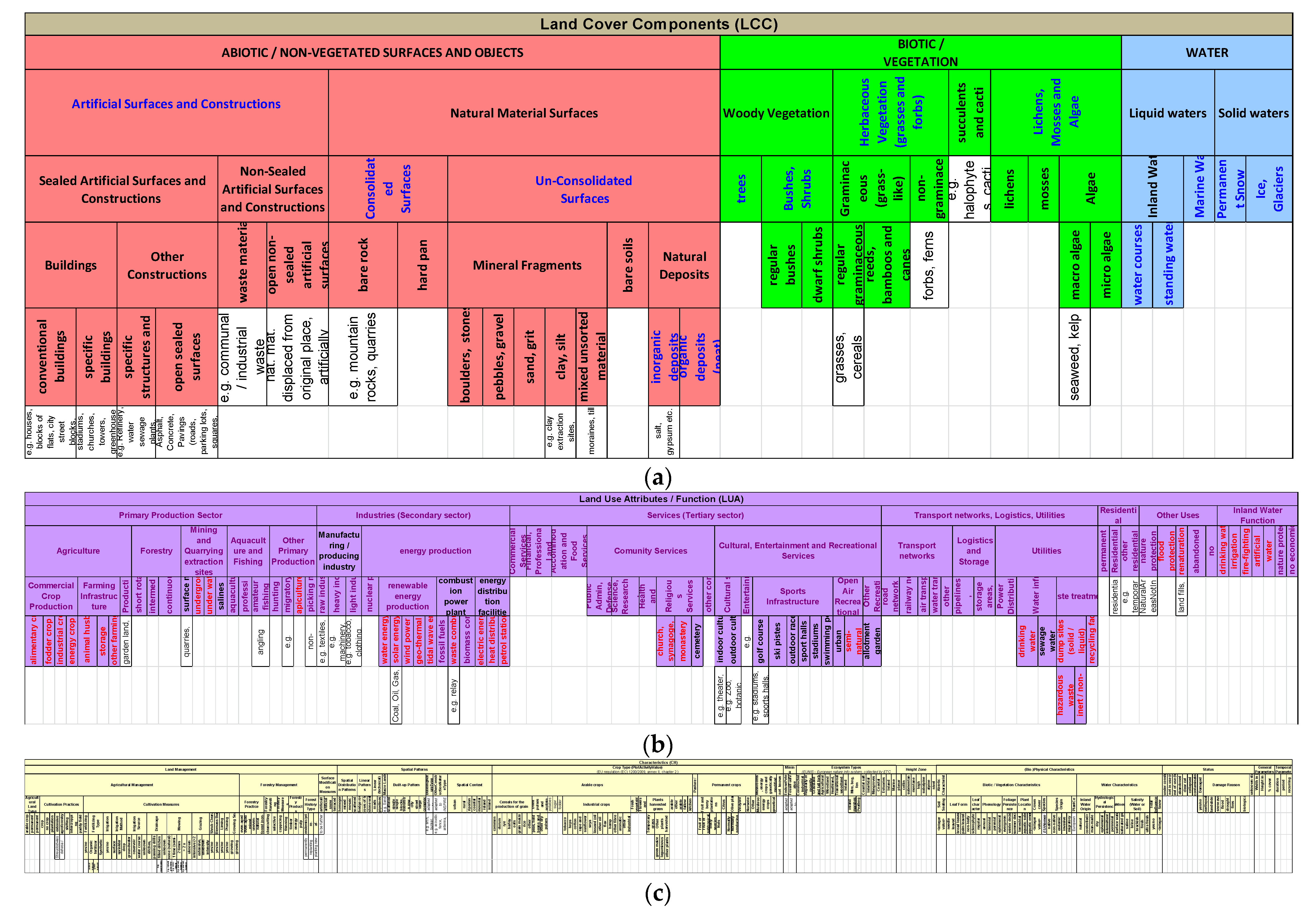

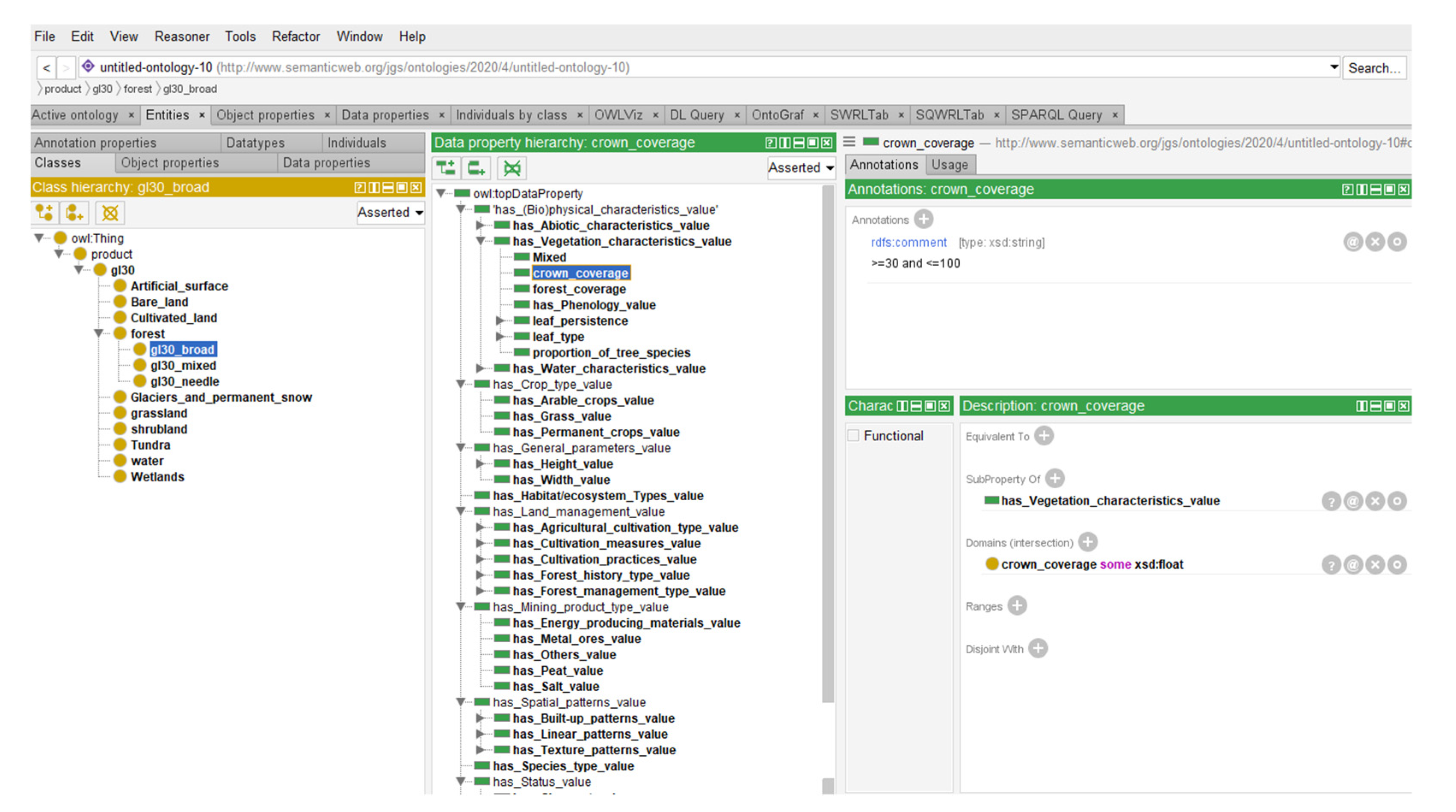

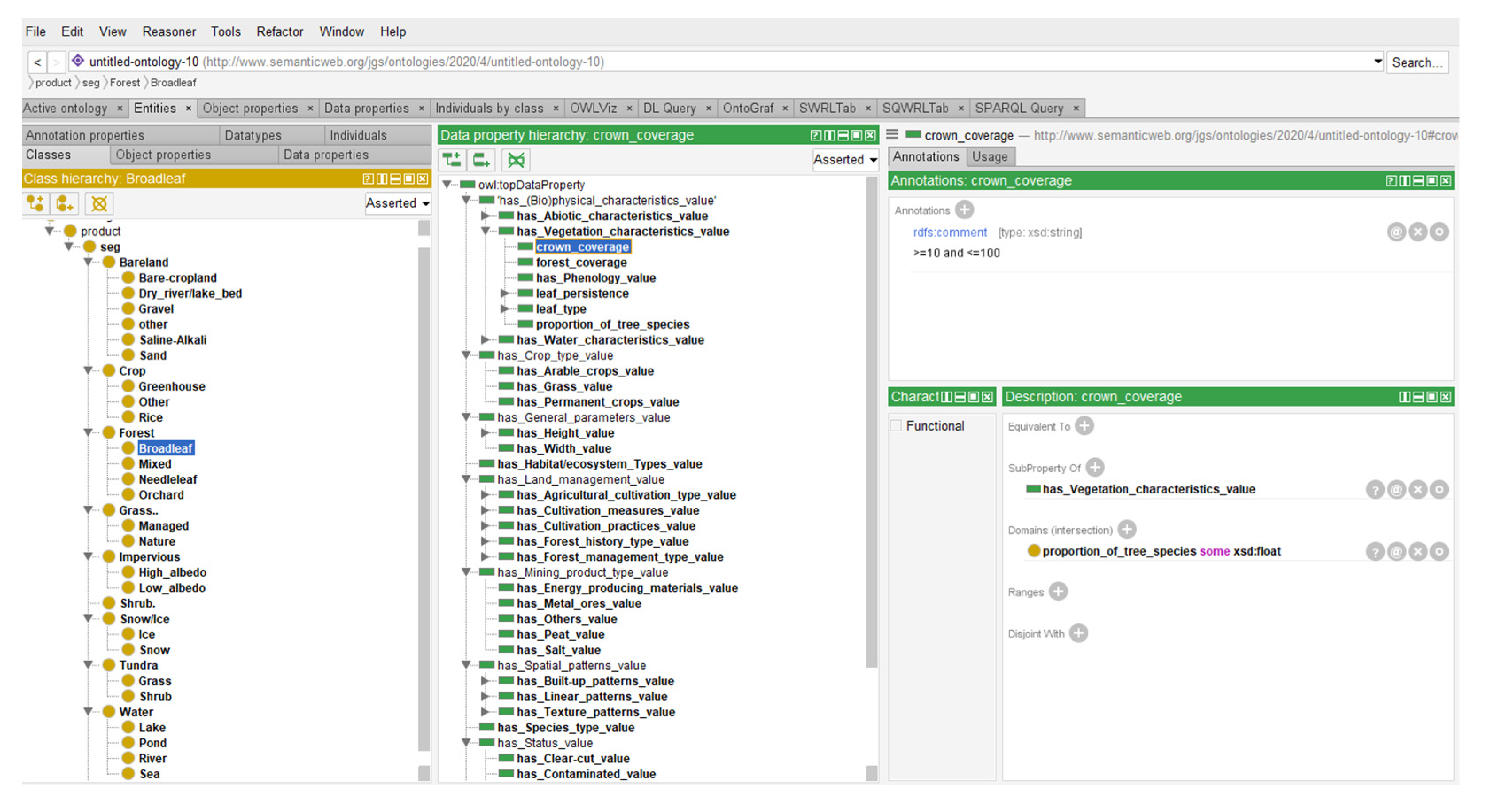
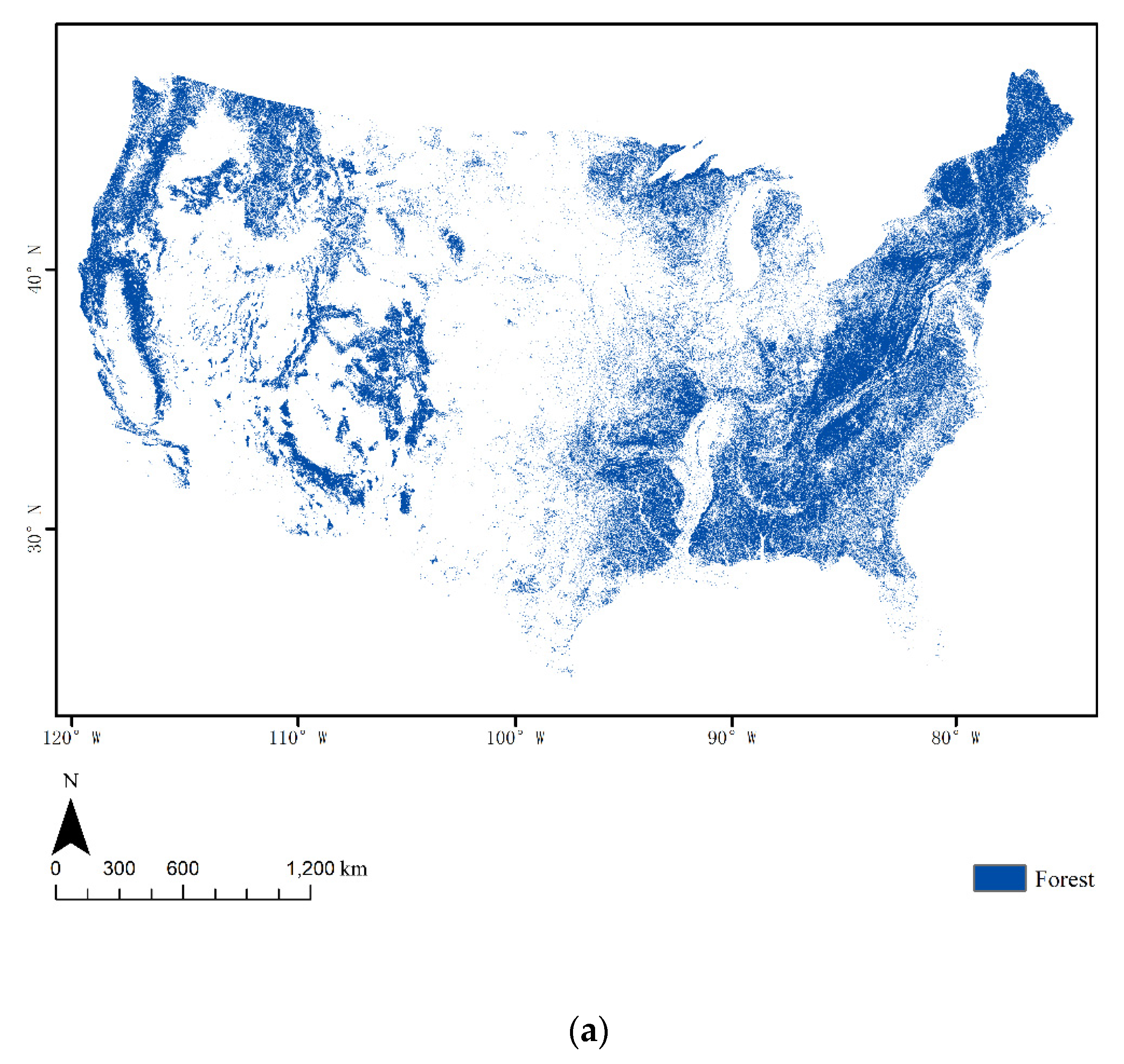
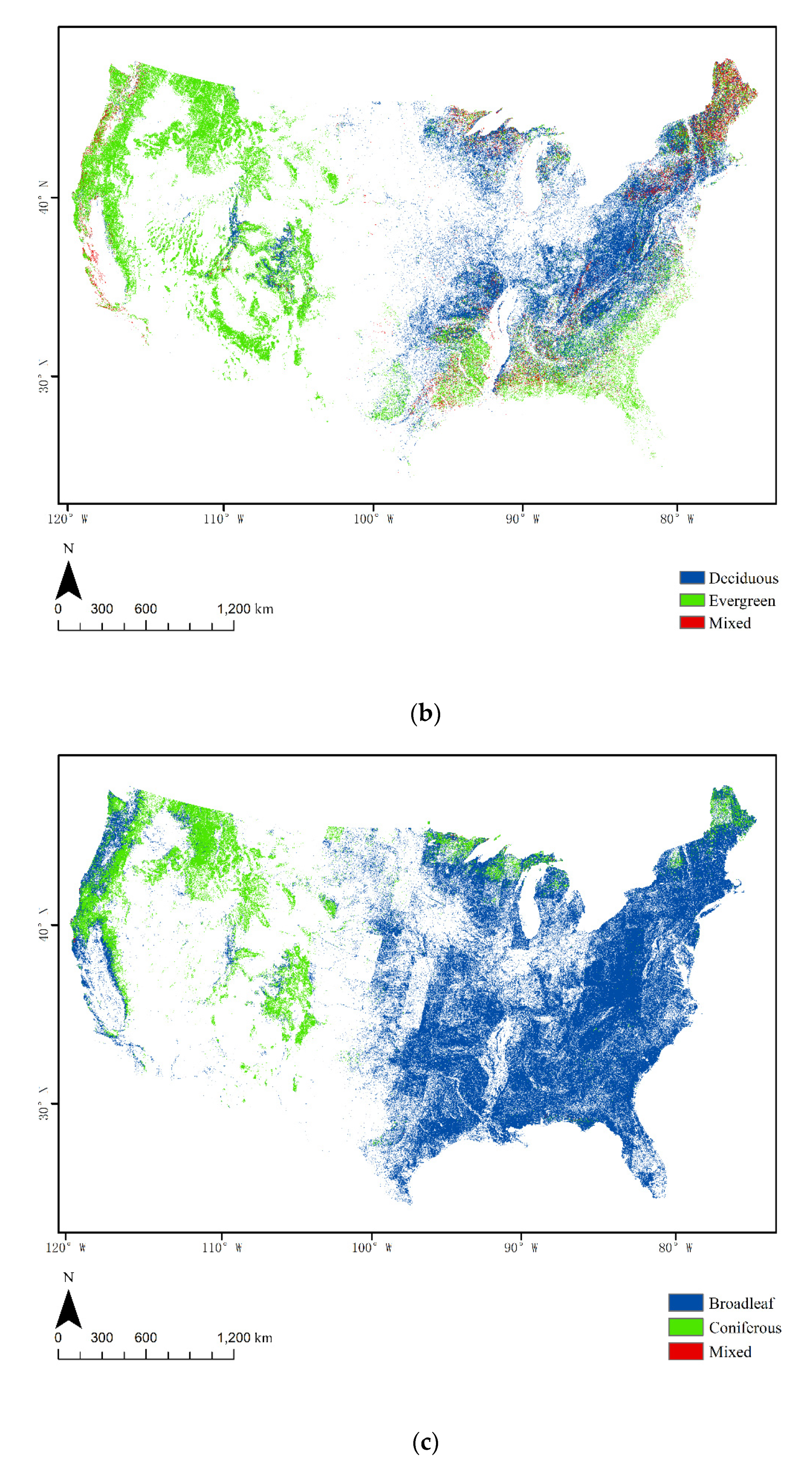
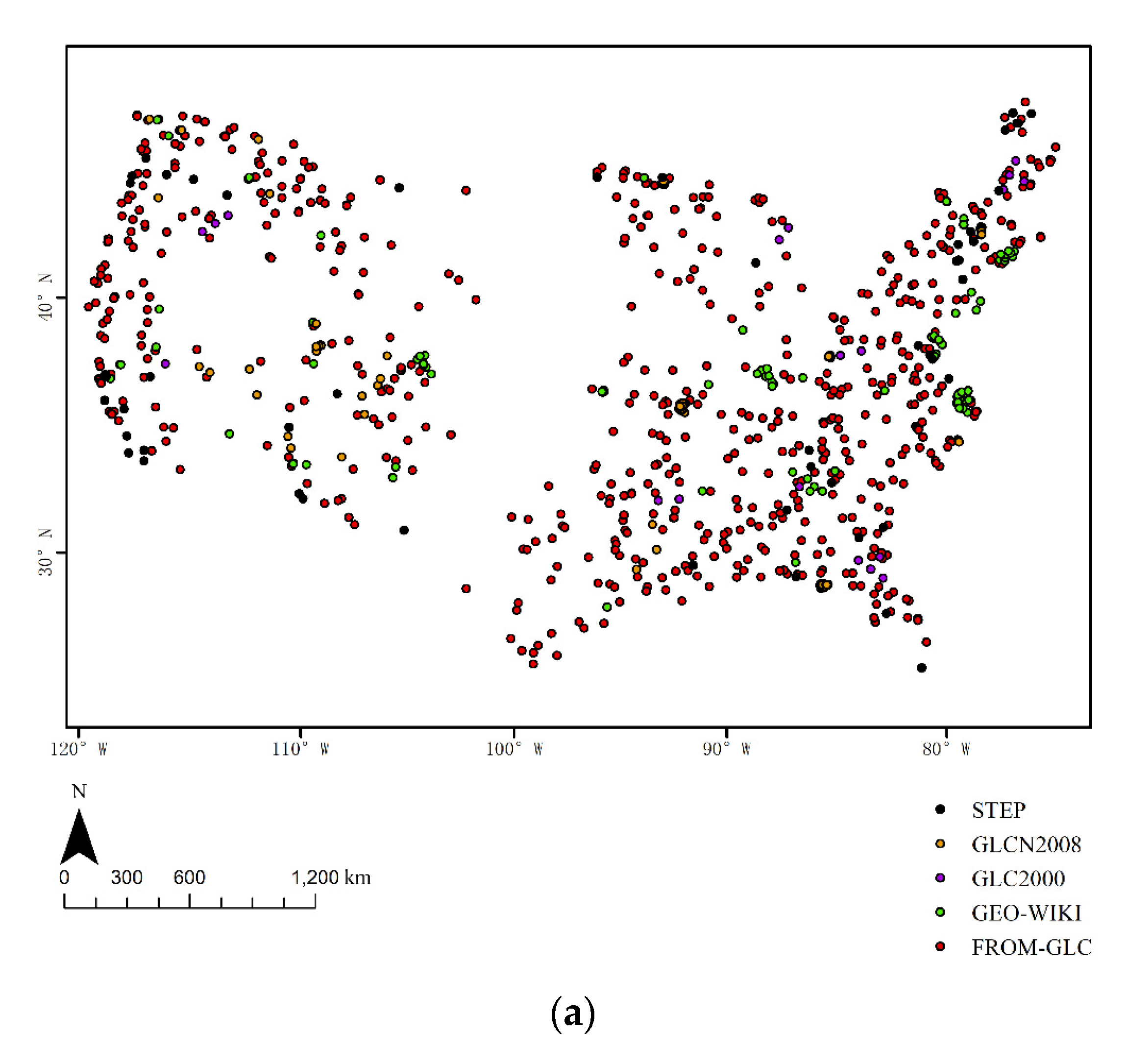



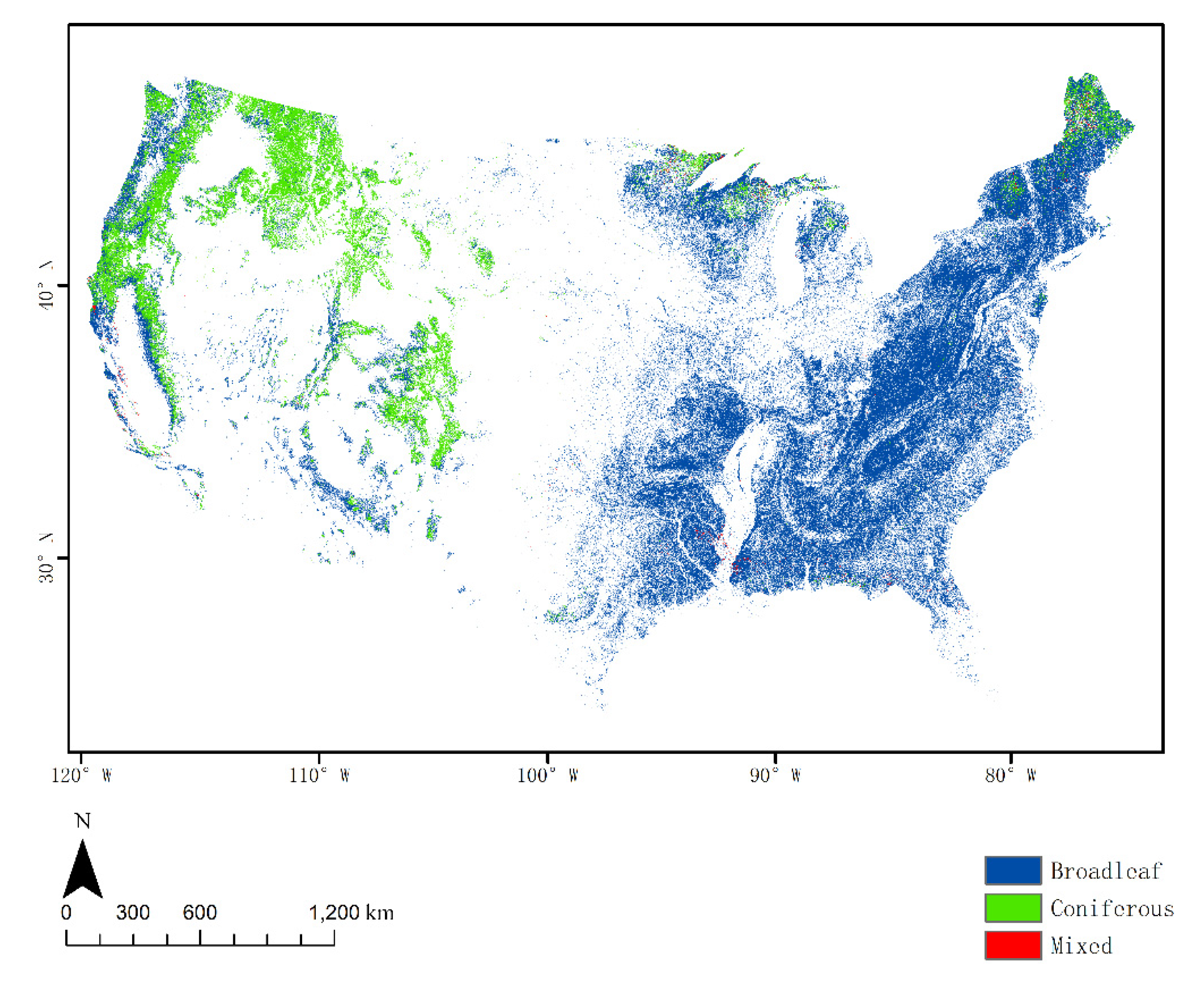
| Source Product | Globeland30 | Broadleaf Forest | Coniferous Forest | Broadleaf Coniferous Mixed Forest | |
|---|---|---|---|---|---|
| NLCD2011 | deciduous forest | ||||
| evergreen forest | |||||
| deciduous evergreen mixed forest | |||||
| FROM-GLC-Seg | broadleaf forest | ||||
| coniferous forest | |||||
| broadleaf coniferous mixed forest | |||||
| Product Name | First Level | Second Level | Definition |
|---|---|---|---|
| Globeland30 | Forest | Broad-leaf forest | The forest with broadleaf tree species is built in groups, with a crown covering more than 30.0% of the land, and the height of the tree is more than 5 m high. |
| Coniferous forest | The general name of various forest plant communities composed of coniferous tree species, the crown coverage of more than 30.0% of the land, the height of the tree is more than 5 m. | ||
| Mixed forest | Conifers and broadleaf trees do not cover more than 60.0% of the total vegetation cover. | ||
| NLCD 2011 | Forest | Deciduous forest | Areas dominated by trees generally greater than 5 m tall, and greater than 20.0% of total vegetation cover. More than 75.0% of the tree species shed foliage simultaneously in response to seasonal change. |
| Evergreen forest | Areas dominated by trees generally greater than 5 m tall, and greater than 20.0% of total vegetation cover. More than 75.0% of the tree species maintain their leaves all year. Canopy is never without green foliage. | ||
| Mixed forest | Areas dominated by trees generally greater than 5 m tall, and greater than 20.0% of total vegetation cover. Neither deciduous nor evergreen species are greater than 75.0% of total tree cover. | ||
| FROM-GLC-Seg | Forest | Broadleaf | Usually higher reflectivity than conifer species in the near infrared (NIR) spectral band. Shaded and sunlit sides less contrast. Tree height is more than 5 m. Tree cover percentage is more than 15.0%. The crown density is more than 10.0%. |
| Coniferous | Lower reflectivity than broadleaf trees in the NIR band. Tree height is more than 5 m. Tree cover percentage is more than 15.0%. The crown density is more than 10.0%. | ||
| Mixed | Neither coniferous nor broadleaf trees dominate in a mixed forest stand. Tree height is more than 5 m. Tree cover percentage is more than 15.0%. The crown density is more than 10.0%. |
| Category Name | Definition | Stem Extraction Result | ||||||
|---|---|---|---|---|---|---|---|---|
| Broadleaf forest | having relatively broad rather than needle like or scale like leaves | width (broad) (01) | leaf (01) | forest (01) | ||||
| Coniferous forest | of or relating to or part of trees or shrubs bearing cones and evergreen leaves | part (01) | tree (01) | shrub (01) | cone (03) | evergreen (01) | leaf (01) | forest (01) |
| Deciduous forest | shedding foliage at the end of the growing season | shedding (02) | foliage (01) | end (02) | growing (01) | season (02) | forest (01) | |
| Evergreen forest | a plant having foliage that persists and remains green throughout the year | plant (02) | foliage (01) | green (01) | year (01) | forest (01) | ||
| Mixed forest | Composition of mixed tree species | blend (Mixed) (01) | tree (01) | forest (01) | ||||
| Land Cover Product | Globeland30 | Broadleaf Forest | Coniferous Forest | Broadleaf Coniferous Mixed Forest | |||||||
|---|---|---|---|---|---|---|---|---|---|---|---|
| Source Product | |||||||||||
| definition | lexical | Average | definition | lexical | Average | definition | lexical | Average | |||
| NLCD2011 | deciduous forest | 0.545 | 0.500 | 0.523 | 0.570 | 0.647 | 0.609 | 0.570 | 0.412 | 0.491 | |
| evergreen forest | 0.680 | 0.471 | 0.576 | 0.722 | 0.471 | 0.597 | 0.762 | 0.324 | 0.543 | ||
| deciduous evergreen mixed forest | 0.540 | 0.313 | 0.427 | 0.576 | 0.344 | 0.460 | 0.657 | 0.471 | 0.564 | ||
| FROM-GLC-Seg | broadleaf forest | 1.000 | 1.000 | 1.000 | 0.788 | 0.412 | 0.600 | 1.000 | 0.500 | 0.750 | |
| coniferous forest | 0.655 | 0.412 | 0.534 | 1.000 | 1.000 | 1.000 | 1.000 | 0.500 | 0.750 | ||
| broadleaf coniferous mixed forest | 0.685 | 0.500 | 0.593 | 0.867 | 0.500 | 0.684 | 1.000 | 1.000 | 1.000 | ||
| Land Cover Components (LCC) | Land Use AtTributes/Function (LUA) | Characteristics (CH) | ||||||||||||||||||||||
|---|---|---|---|---|---|---|---|---|---|---|---|---|---|---|---|---|---|---|---|---|---|---|---|---|
| Biotic/Vegetation | Primary Production Sector | Spatial Patterns | Land Management | (Bio-)Physical Characteristics | General Parameters | |||||||||||||||||||
| Woody Vegetation | Forestry | Texture Patterns | Forest Management Type | Forest History Type | Vegetation Characteristics | Height (m) | Cover (%) | |||||||||||||||||
| Trees | Short rotation | Interim or long rotation | Continuous cover, selective logging | Homogenous | Mixed, heterogeneous | Mosaic | Scattered | Intensive monoculture | Regular | Extensive (selective logging) | Endemic, primary | Reforestation | Afforestation | Leaf form | Foliage persistence | Crown cover density (%) | Percentage of Ppecies (%) | (Integer value) | (Integer value) | |||||
| Broadleaved trees | Needle-leaved trees | Palm tree | Coniferous/needle leaved | Broad leaved | Evergreen | Winter deciduous | Summer deciduous | (Integer value) | (Integer value) | |||||||||||||||
| Product | Globeland30 | Broadleaf Forest | Coniferous Forest | Broadleaf Coniferous Mixed Forest | |
|---|---|---|---|---|---|
| Source Product | |||||
| NLCD2011 | deciduous forest | 0.713 | 0.717 | 0.634 | |
| evergreen forest | 0.729 | 0.734 | 0.655 | ||
| deciduous evergreen mixed forest | 0.635 | 0.640 | 0.791 | ||
| FROM-GLC-Seg | broadleaf forest | 0.892 | 0.866 | 0.809 | |
| coniferous forest | 0.858 | 0.892 | 0.809 | ||
| broadleaf coniferous mixed forest | 0.783 | 0.802 | 0.975 | ||
| Source Product | Globeland30 | Broadleaf Forest | Coniferous Forest | Broadleaf Coniferous Mixed Forest | |
|---|---|---|---|---|---|
| NLCD2011 | deciduous forest | 0.737 | 0.107 | 0.082 | |
| evergreen forest | 0.450 | 0.390 | 0.096 | ||
| deciduous evergreen mixed forest | 0.455 | 0.140 | 0.300 | ||
| FROM-GLC-Seg | broadleaf forest | 0.639 | 0.077 | 0.060 | |
| coniferous forest | 0.215 | 0.597 | 0.010 | ||
| broadleaf coniferous mixed forest | 0.297 | 0.154 | 0.505 | ||
| Product Name | Globeland30 | Broadleaf Forest | Coniferous Forest | Broadleaf Coniferous Mixed Forest | |
|---|---|---|---|---|---|
| Source Data | |||||
| NLCD2011 | deciduous forest | 0.657 | 0.478 | 0.402 | |
| evergreen forest | 0.585 | 0.573 | 0.431 | ||
| deciduous evergreen mixed forest | 0.506 | 0.413 | 0.552 | ||
| FROM-GLC-Seg | broadleaf forest | 0.844 | 0.514 | 0.540 | |
| coniferous forest | 0.535 | 0.830 | 0.523 | ||
| broadleaf coniferous mixed forest | 0.558 | 0.547 | 0.827 | ||
| Type | Overall Accuracy | User Accuracy | Commission Error | Omission Error | Producer Accuracy |
|---|---|---|---|---|---|
| Broadleaf | 0.826 | 0.174 | 0.160 | 0.840 | |
| Coniferous | 0.720 | 0.280 | 0.098 | 0.902 | |
| Mixed | 0.483 | 0.517 | 0.216 | 0.784 | |
| Sum | 0.753 |
| Type | Overall Accuracy | User Accuracy | Commission Error | Omission Error | Producer Accuracy |
|---|---|---|---|---|---|
| Broadleaf | 0.826 | 0.174 | 0.148 | 0.852 | |
| Coniferous | 0.720 | 0.280 | 0.084 | 0.916 | |
| Mixed | 0.600 | 0.400 | 0.122 | 0.878 | |
| Sum | 0.763 |
Publisher’s Note: MDPI stays neutral with regard to jurisdictional claims in published maps and institutional affiliations. |
© 2021 by the authors. Licensee MDPI, Basel, Switzerland. This article is an open access article distributed under the terms and conditions of the Creative Commons Attribution (CC BY) license (https://creativecommons.org/licenses/by/4.0/).
Share and Cite
Zhu, L.; Jin, G.; Gao, D. Integrating Land-Cover Products Based on Ontologies and Local Accuracy. Information 2021, 12, 236. https://doi.org/10.3390/info12060236
Zhu L, Jin G, Gao D. Integrating Land-Cover Products Based on Ontologies and Local Accuracy. Information. 2021; 12(6):236. https://doi.org/10.3390/info12060236
Chicago/Turabian StyleZhu, Ling, Guangshuai Jin, and Dejun Gao. 2021. "Integrating Land-Cover Products Based on Ontologies and Local Accuracy" Information 12, no. 6: 236. https://doi.org/10.3390/info12060236
APA StyleZhu, L., Jin, G., & Gao, D. (2021). Integrating Land-Cover Products Based on Ontologies and Local Accuracy. Information, 12(6), 236. https://doi.org/10.3390/info12060236







